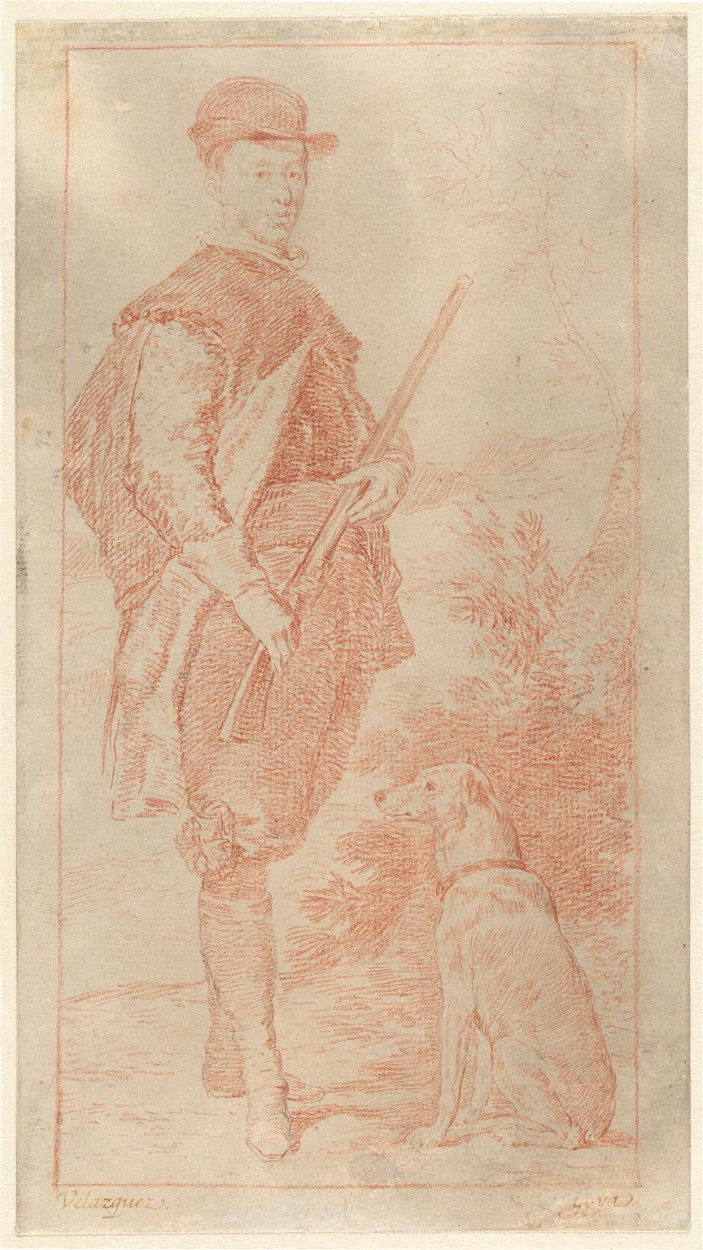Francisco José de Goya y Lucientes, Zeichner
Diego Rodríguez de Silva y Velázquez, Erfinder
Infant Don Fernando, als Jäger - Vorzeichnung für eine Radierung nach einem Gemälde von Velázquez, 1778-79, vor 1792
This is a preliminary drawing for Goya's unpublished etching[1] after the painting by Diego Velázquez at the Museo Nacional del Prado;[2] a number of trial proofs in different states are known.[3] Of much the same importance as the great, imposing royal equestrian portraits that represented a ruler's competence as a leader, portraits of leaders in hunting costume demonstrated their familiarity with weapons and the conduct of war.[4] Goya had already published five equestrian portraits in July 1778–Philip III, Margaret of Austria, Philip IV, Elisabeth of Bourbon, and the Count-Duke of Olivares-but he also hoped to acquaint a broader public with Velázquez's portraits of Philip IV, Prince Baltasar Carlos, and the Cardinal Infante Don Fernando as hunters. Goya did not publish the works, but there is an extensive series of trial proofs of the Infante Don Fernando that show how close he was to finishing that work.[5]
Goya's divergence from the Velázquez original is particularly striking here. He narrowed the format of the portrait of the Cardinal Infante to the point that he had to greatly reduce the size of the dog in order to fit it into the picture. He also reduced the tree at the right; in Velázquez's work, this branch extends beyond the top edge. In Goya's drawing, all that remains is a thin, decorative twig. Having made the picture narrower, Goya even had to shorten Don Fernando's rifle, until all the attributes of the hunter were greatly minimized in his version of the portrait. His hunter also hunts, but no longer with all the baroque trappings, no longer as a ruler forced to play a prescribed role. Velázquez had also made it clear, precisely with these attributes, that the Infante Don Fernando was in any case not one of the “highest" rulers; King Philip IV himself stands relaxed in contrapposto and centered in front of a large tree that lends him strength and protection. At his side, in a parallel pose, his mastiff gazes in the same direction as his master. The king holds his gun casually in one hand. Before the painting of the prince Baltasar Carlos as hunter was trimmed on the right, he too was probably centered, and with a tree at his back, though at a greater distance than in the portrait of his father. There, a large branch serves as a sort of natural baldachin that places him under special protection. The boy still rests his gun on the ground, and his dogs serve to frame him. In contrast, Don Fernando firmly holds his rifle with both hands, and his dog does not stand at his side, but in front and facing him. The Cardinal Infante occupies the entire left half of the picture at the greatest possible distance from the tree at the right edge of the picture. In all three paintings, one sees the same lordly attributes, but their treatment was clearly tailored to the subject's status-king, heir apparent, and cardinal infante.
What Goya began in his drawing, namely a reduction of the lordly attributes and, accordingly, a less functional but more personal rendering of the subject, led in the resulting aquatint to one of the most autonomous and convincing graphic compositions from this series.
Jens Hoffmann-Samland
1 Harris 1964, no. 11
2 The Cardinal-Infante Fernando de Austria, ca. 1633, oil on canvas, 75 316 X 42 1/8 in. (191 x 107 cm), Madrid, Museo Nacional del Prado, inv. no. P 1186.
3 Hoffmann-Samland 2011, 278.
4 In 1640, Diego de Saavedra Fajardo formulated an educational program for princes in which hunting was accorded thus: “In it youth ripens, acquires strength and agility, schools itself in the military arts, becomes familiar with the terrain, learns to assess, to wait at the right time, to attack and wound; learns to exploit situations and apply the strategems of war." In other words, the spilled blood and the contortions of the dying animals would purge their emotions, strengthen their courage, and foster a nobility of spirit capable of surmounting any sense of fear. See Saavedra Fajardo 1988, 36.
5 See Sayre and Boggs 1974, 46-49; and Gallwitz and Garín (dirs.) 1991, 122-42.

